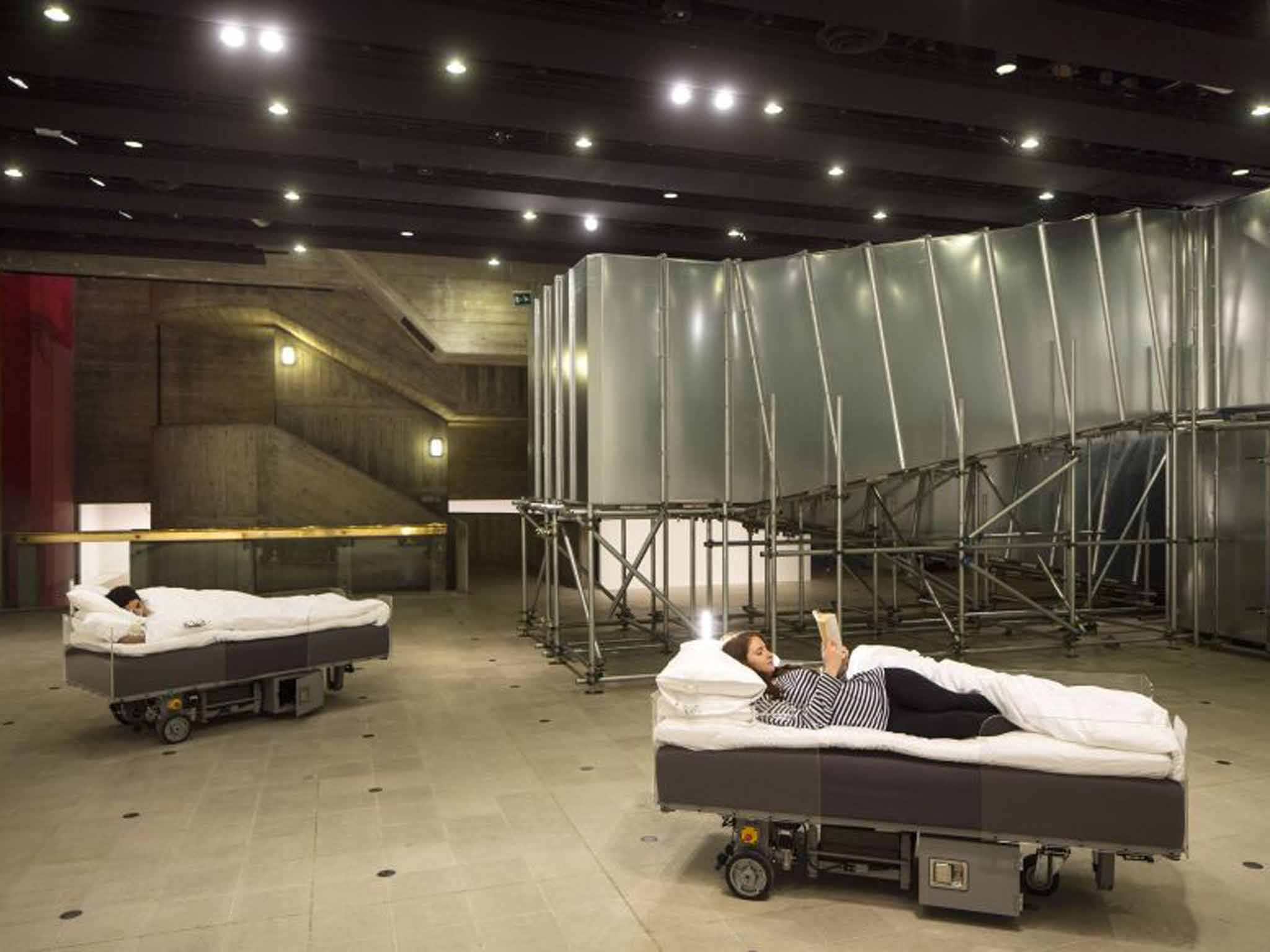'Two Roaming Beds' at the Hayward: Why have sleep and art become such cosy bedfellows?
Can a museum ever really come alive in the dead of night?

Not everybody loves a museum. Marcel Duchamp, that red-shirted son of a notary from Normandy, hated them. He felt that objects imprisoned inside museums became grotesque, self-important simulacra of themselves, dead and embalmed, reeking of all the sterility of systematisation. His great wish was to break down the division between the world and the artist, to let art flow into the street like a great, unbridled sewer gush – and let the museums drift away, stinking, into oblivion.
Napoleon, who briefly strode the world's stage some decades before Duchamp, couldn't have disagreed more. His great plan was to transform the Louvre into a super-museum. And to that end, in the wake of his swift and mightily skilful sequence of pan-European conquests during the first years of the 19th century, he pillaged objects from here, there and everywhere. His great museum would become both a tool of universal enlightenment and an unforgettable homage to himself: a man who believed 100 per cent in imprisoning objects in museums, and frog-marching audiences into their presence.
But neither Duchamp nor Napoleon could have anticipated the degree to which future art, in its museums and gallery spaces, would not only step down from its fusty pedestal as a static source of knowledge and enlightenment, but also merge into immersive, night-hours' mass entertainment. In the past, there have been giant ship's containers to wander in, and shattered rooms aplenty to walk through. More recently, Anthony Gormley created a 'piece' (a blacked-out hotel room) where you could stay the night. Grayson Perry's new Essex house is available for weekenders to rent. And there are even adult sleepovers in the British and Natural History Museums, where no doubt they hope for real life to imitate a Ben Stiller film.
Which leads us to an important question. Can a museum ever really come alive in the dead of night? Well, it really will – soon – at a space called the Hayward Gallery, which exists among other temples of cultural enlightenment on London's South Bank.
What is the Hayward Gallery for? It is a space that seems to exist to stage temporary exhibitions that will shock and engage us. A forthcoming Carsten Holler retrospective is its latest extravagance. The gallery is challenging us to book a sleepover there (at no little expense) and to spend at least some of the hours of darkness part-slumbering, and perhaps part-ruminating, in one of Carsten Holler's mobile beds as it pinball-racketeers about the gallery. Once slightly weary of that, we can then choose to roar down an isometric slide on the outside of the building or strap on a pair of upside-down goggles. And all during the hours of darkness.
But what will all this do for us? Will darkness really bring about some fundamental shift of consciousness or a moment or two of epiphanic enlightenment (as Holler – perhaps in with a cut – semi-seriously suggests)? Will those dragging hours in the gallery in the end prove to be something more than a long night of fairground high jinks? Or do art and darkness in the context of the museum have more interesting things to say to each other?
Certainly, artists and culture critics have often acknowledged the fructifying possibilities of sleep when taken in regular conjunction with art and darkness. Many of those artists were called Surrealists, and they believed that it was from the hidden depths, the darkness of the sleeping (or perhaps part-sleeping, part-juddering) self, that the truth emerged; and that truth included the imaginative truth of dreams, which could readily be transcribed by the artist. As, indeed, it often was.
So perhaps what will come later is an entire exhibition which documents the Hayward Holler experience, complete with all its ecstacies, its aching necks, its throbbing heads, and its passing nano-seconds of sheer, no-holds-barred sublimity. And, as with many other exhibitions of works by minor or proto-Surrealists, even the briefest and baldest account of the intensity of the experience is likely to be of much greater interest than the overwhelming majority of the works themselves. We shall see.
But what is more, asking if museums can come alive at night reminds us yet again that coupling those two ideas together – darkness and gallery spaces – has often created a fruitful context for terror, mystery and all kinds of varieties of imaginative roaming.
Writers for children have known this for decades, of course. The very idea of such a thing has always been imaginatively stimulating: all those objects waking up and enjoying the kind of free-flowing life that the enviable creatures of day experience as a matter of course is the stuff of many a picture book for children, not to mention film directors.
'Roaming Beds' is at the Hayward Gallery, Southbank Centre, London SE1, 10-20 June
Subscribe to Independent Premium to bookmark this article
Want to bookmark your favourite articles and stories to read or reference later? Start your Independent Premium subscription today.

Join our commenting forum
Join thought-provoking conversations, follow other Independent readers and see their replies